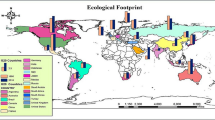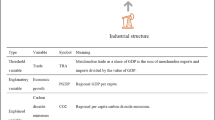Abstract
The disastrous consequences of climate change for human life and environmental sustainability have drawn worldwide attention. Increased global warming is attributed to anthropogenic greenhouse gas (GHG) emissions, biodiversity loss, and deforestation due to industrial output and huge consumption of fossil fuels. Financial inclusion can be acted as an adaptation or a mitigation measure for environmental degradation. This study analyzed the impact of financial inclusion on environmental degradation in OIC countries for the period 2004–2018. A novel approach, “Dynamic Common Correlated Effects (DCCE)” is used to tackle the problem of heterogeneity and cross-sectional dependence (CSD). Various GHG emissions along with deforestation and ecological footprint are used as indicators of environmental degradation. Long-run estimation confirms that financial inclusion is positively and significantly linked with CO2 emission, CH4 emission, and deforestation while negatively correlated with ecological footprint and N2O emission in overall and higher-income OIC economies. An inverted U-shaped environmental Kuznets curve (EKC) is validated when ecological footprint, CO2, and CH4 are used in all panels of OIC countries. An inverted U-shaped EKC is also observed for deforestation in lower-income and overall OIC countries. In the case of N2O emission, however, a U-shaped EKC appears in lower-income and overall OIC countries. It is suggested that the governments of OIC countries should continue to have easy access to financial services and maintain sustainable use of forests and biocapacity management to address environmental challenges.
Similar content being viewed by others
Data Availability
The datasets used in this study are available from the corresponding author on reasonable request.
Notes
This association is similar to the inverted-U shaped association between GDP and income inequality defines by Kuznets (1955).
Metric tons of carbon dioxide equivalent
Data related to financial inclusion prior to 2004 is not available for OIC countries.
i.e., Low-income, lower-middle-income, upper-middle-income, and high-income countries.
PMG (pooled mean group) is developed by Pesaran et al. (1999).
MG (mean group) is developed by Pesaran and Smith (1995).
CCE (common correlated effects) is presented by Pesaran (2006).
Jackknife command is utilized in STATA for obtaining robust values of standard errors and variance, especially in case of small data size.
The STATA command PCA is used for obtaining the financial inclusion index (FIN).
For instance, see Xue et al. (2021)
Equation 13 of the model specification defines the formula for calculating the EKC turning point.
References
Ali, S., Yusop, Z., Kaliappan, S. R., & Chin, L. (2020). Dynamic common correlated effects of trade openness, FDI, and institutional performance on environmental quality: evidence from OIC countries. Environmental Science and Pollution Research, 1-12.
Ali S, Yusop Z, Kaliappan SR, Chin L (2021) Trade-environment nexus in OIC countries: fresh insights from environmental Kuznets curve using GHG emissions and ecological footprint. Environ Sci Pollut Res 28(4):4531–4548
Al-Mulali U, Ozturk I, Lean HH (2015) The influence of economic growth, urbanization, trade openness, financial development, and renewable energy on pollution in Europe. Nat Hazards 79(1):621–644
Antweiler W, Copeland RB, Taylor MS (2001) Is free trade good for the emissions: 1950-2050. Rev Econ Stat 80:15–27
Balsalobre-Lorente D, Gokmenoglu KK, Taspinar N, Cantos-Cantos JM (2019) An approach to the pollution haven and pollution halo hypotheses in MINT countries. Environ Sci Pollut Res 26(22):23010–23026
Baltagi BH, Feng Q, Kao C (2012) A Lagrange multiplier test for cross-sectional dependence in a fixed effects panel data model. J Econ 170(1):164–177
Bashir F, Chaudhry IS, Ahmad R, Habib F (2020) An econometric investigation of sectoral output and environmental degradation in Pakistan. Review of Education, Administration & LAW 3(3):443–456
Baum CF, Schaffer ME, Stillman S (2007) Enhanced routines for instrumental variables/generalized method of moments estimation and testing. Stata J 7(4):465–506
Breusch TS, Pagan AR (1980) The Lagrange multiplier test and its applications to model specification in econometrics. Rev Econ Stud 47(1):239–253
Chaudhry IS, Azali M, Faheem M, Ali S (2020) Asymmetric dynamics of oil price and environmental degradation: evidence from Pakistan. Review of Economics and Development Studies 6(1):1–12
Chaudhry IS, Ali S, Bhatti SH, Anser MK, Khan AI, Nazar R (2021) Dynamic common correlated effects of technological innovations and institutional performance on environmental quality: evidence from East-Asia and Pacific countries. Environ Sci Pol 124:313–323
Chibba M (2009) Financial inclusion, poverty reduction and the millennium development goals. Eur J Dev Res 21(2):213–230
Choi I (2006) Nonstationary Panels. In: Patterson K, Mills TC (eds) Palgrave handbooks of econometrics 1. Palgrave Macmillan, New York, pp 11–539
Chudik A, Pesaran MH (2015) Common correlated effects estimation of heterogeneous dynamic panel data models with weakly exogenous regressors. J Econ 188(2):393–420
Combes JL, Delacote P, Motel PC, Yogo TU (2018) Public spending, credit and natural capital: does access to capital foster deforestation? Econ Model 73:306–316
Ditzen J (2019). Estimating long run effects in models with cross-sectional dependence using xtdcce2. Centre for Energy Economics Research and Policy (CEERP) Working Paper No, 7.
Dogan E, Inglesi-Lotz R (2020) The impact of economic structure to the environmental Kuznets curve (EKC) hypothesis: evidence from European countries. Environ Sci Pollut Res 27(11):12717–12724
Dogan E, Seker F (2016) An investigation on the determinants of carbon emissions for OECD countries: empirical evidence from panel models robust to heterogeneity and cross-sectional dependence. Environ Sci Pollut Res 23(14):14646–14655
Dreher A (2006) Does globalization affect growth? Evidence from a new index of globalization. Appl Econ 38(10):1091–1110
Frankel JA, Romer DH (1999) Does trade cause growth? Am Econ Rev 89(3):379–399
Global Footprint Network (2018) Global footprint network. Obtenido de Global Footprint Network: http://www.footprintnetwork.org online accessed on 10-10-2020
Grossman GM, & Krueger AB (1991). Environmental impacts of a North American free trade agreement (No. w3914). National Bureau of economic research
Grossman GM, Krueger AB (1995) Economic growth and the environment. Q J Econ 110(2):353–377
Hussain S, Ahmad T, & Shahzad SJH (2021). Financial inclusion and CO2 emissions in Asia: implications for environmental sustainability
Im KS, Pesaran MH, Shin Y (2003) Testing for unit roots in heterogeneous panels. J Econ 115(1):53–74
Javid M, Sharif F (2016) Environmental Kuznets curve and financial development in Pakistan. Renew Sust Energ Rev 54:406–414
Jensen AL (1996) Beverton and Holt life history invariants result from optimal trade-off of reproduction and survival. Can J Fish Aquat Sci 53(4):820–822
Katircioglu ST, Taspinar N (2017) Testing the moderating role of financial development in an environmental Kuznets curve: empirical evidence from Turkey. Renew Sust Energ Rev 68:572–586
Kuznets S (1955) Economic growth and income inequality. Am Econ Rev 45(1):1–28
Le HP, Ozturk I (2020) The impacts of globalization, financial development, government expenditures, and institutional quality on CO 2 emissions in the presence of environmental Kuznets curve. Environ Sci Pollut Res 27(18):22680–22697
Le TH, Le HC, Taghizadeh-Hesary F (2020) Does financial inclusion impact CO2 emissions? Evidence from Asia. Financ Res Lett 34:101451
Levin A, Lin CF, Chu CSJ (2002) Unit root tests in panel data: asymptotic and finite-sample properties. J Econ 108(1):1–24
Manji A (2010) Eliminating poverty?‘Financial inclusion’, access to land, and gender equality in international development. The Modern Law Review 73(6):985–1004
Murshed M (2020). Revisiting the deforestation-induced EKC hypothesis: the role of democracy in Bangladesh. GeoJournal, 1-22
Okoye LU, Erin, O., & Modebe, N. J. (2017). Financial inclusion as a strategy for enhanced economic growth and development. The Journal of Internet Banking and Commerce, 1-14
Olaniyi E (2017) Back to the land: The impact of financial inclusion on agriculture in Nigeria. Iranian Economic Review 21(4):885–903
Parveen S, Sadiqa BA, Yasmin F, Ali S (2021) Impact of energy consumption on economic growth, foreign direct investment and environmental degradation: evidence from Pakistan. Review of Applied Management and Social Sciences 4(1):13–25
Pesaran MH (2004) General diagnostic tests for cross section dependence in panels. CESifo Working Papers 1233:255–260
Pesaran MH (2006) Estimation and inference in large heterogeneous panels with a multifactor error structure. Econometrica 74(4):967–1012
Pesaran MH (2007) A simple panel unit root test in the presence of cross-section dependence. J Appl Econ 22(2):265–312
Pesaran MH, Smith R (1995) Estimating long-run relationships from dynamic heterogeneous panels. J Econ 68(1):79–113
Pesaran MH, Yamagata T (2008) Testing slope homogeneity in large panels. J Econ 142(1):50–93
Pesaran MH, Shin Y, Smith RP (1999) Pooled mean group estimation of dynamic heterogeneous panels. J Am Stat Assoc 94(446):621–634
Pesaran MH, Ullah A, Yamagata T (2008) A bias-adjusted LM test of error cross-section independence. Econ J 11(1):105–127
Raza MS, Tang J, Rubab S, Wen X (2019) Determining the nexus between financial inclusion and economic development in Pakistan. Journal of Money Laundering Control 22:195–209
Renzhi N, Baek YJ (2020) Can financial inclusion be an effective mitigation measure? evidence from panel data analysis of the environmental Kuznets curve. Financ Res Lett 37:101725
Salahuddin M, Gow J, Ozturk I (2015) Is the long-run relationship between economic growth, electricity consumption, carbon dioxide emissions and financial development in Gulf Cooperation Council Countries robust? Renew Sust Energ Rev 51:317–326
SESRIC (2019) OIC Economic Outlook. In: Statistical. Economic and Social Research and Training Centre for Islamic Countries (SESRIC), Ankara
Shahbaz M, Mallick H, Mahalik MK, Loganathan N (2015) Does globalization impede environmental quality in India? Ecol Indic 52:379–393
Swamy PA (1970) Efficient inference in a random coefficient regression model. Journal of the Econometric Society, Econometrica, pp 311–323
Tamazian A, Chousa JP, Vadlamannati KC (2009) Does higher economic and financial development lead to environmental degradation: evidence from BRIC countries. Energy Policy 37(1):246–253
Tsurumi T, Managi S (2014) The effect of trade openness on deforestation: empirical analysis for 142 countries. Environ Econ Policy Stud 16(4):305–324
Usman M, Makhdum MSA, Kousar R (2020) Does financial inclusion, renewable and non-renewable energy utilization accelerate ecological footprints and economic growth? Fresh evidence from 15 highest emitting countries. Sustain Cities Soc 65:102590. https://doi.org/10.1016/j.scs.2020.102590
Westerlund J (2007) Testing for error correction in panel data. Oxf Bull Econ Stat 69(6):709–748
World Bank, (2018). Financial inclusion. Retrieved on November 26, 2020. Available at:https://www.worldbank.org/en/topic/financialinclusion/overview#1
Xing T, Jiang Q, Ma X (2017) To facilitate or curb? The role of financial development in China’s carbon emissions reduction process: a novel approach. Int J Environ Res Public Health 14(10):1222
Xue J, Rasool Z, Nazar R, Khan AI, Bhatti SH, Ali S (2021) Revisiting natural resources—globalization-environmental quality nexus: fresh insights from South Asian countries. Sustainability 13(8):4224
Yameogo CEW (2021) Globalization, urbanization, and deforestation linkage in Burkina Faso. Environ Sci Pollut Res 28(17):22011–22021
Zafar MW, Saud S, Hou F (2019) The impact of globalization and financial development on environmental quality: evidence from selected countries in the Organization for Economic Co-operation and Development (OECD). Environ Sci Pollut Res 26(13):13246–13262
Acknowledgements
This paper is a part of the first author’s thesis for his PhD in Finance from Putra Business School, UPM, Malaysia.
Author information
Authors and Affiliations
Contributions
Imran Sharif Chaudhry: conceptualization, data analysis, and writing-original draft. Zulkornain Yusop: supervision, proofreading, and editing. Muzafar Shah Habibullah: writing—methodology and supervision.
Corresponding author
Ethics declarations
Ethics approval
Not applicable
Consent to participate
Not applicable
Consent for publication
Not applicable
Competing interests
The authors declare no competing interests.
Additional information
Responsible Editor: Nicholas Apergis
Publisher’s note
Springer Nature remains neutral with regard to jurisdictional claims in published maps and institutional affiliations.
Appendix
Appendix
Rights and permissions
About this article
Cite this article
Chaudhry, I.S., Yusop, Z. & Habibullah, M.S. Financial inclusion-environmental degradation nexus in OIC countries: new evidence from environmental Kuznets curve using DCCE approach. Environ Sci Pollut Res 29, 5360–5377 (2022). https://doi.org/10.1007/s11356-021-15941-9
Received:
Accepted:
Published:
Issue Date:
DOI: https://doi.org/10.1007/s11356-021-15941-9




